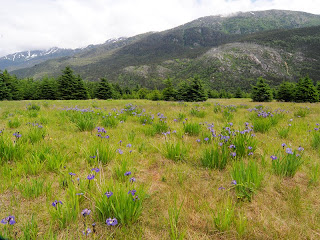“One’s hell. The other’s damnation.” -- Mont Hawthorn, Klondike stampeder, comparing the Chilkoot Pass and the White PassIn 1896, the routes through the mountains from the Pacific to the gold in Dawson City were two: the longer White Pass, or the steeper Chilkoot Pass. Neither was easy, especially when each person was required, by Canadian Immigration, to bring enough provisions to see them through the year -- at least 2000 pounds.
The trail heads for the two passes began in either Dyea or Skagway, less then 10 miles apart. Both places "exploded" into cities almost overnight where the thousands of gold-fevered "stampeders" landed, got supplies for their trip, and hit the trail north.
Most of the gold seekers would not become rich. But the towns did. Supplies were sold at over-inflated prices, saloons and "soiled doves" took their share, native Tlingits were paid handsomely for helping to carry goods on the trail, pack animals (usually old and lame) went for exorbitant prices, and entrepreneurial women sold apple pies for $10 each -- about $250 in today's dollar.
Two years later, the rush was over for them both, but the future of the two towns could not have been more different.
Skagway, with a deep port and a new railroad, prospered. Dyea, with no port and no railroad was doomed.
Today we visited what is left of Dyea.
This is our stalker, Ellen, a Park Ranger. Or maybe we are her stalkers -- all we know is that we have run into her in each of the three days we have been in the area. The first time was on Friday in the Park Visitor Center, on Saturday in the street, and today at Dyea where she was leading our tour. In this picture, she is holding an historic photo of Dyea in front of the field that used to be the town.Only a very few remnants of buildings remain today. This is an example of a "False Front" building, a common tactic used by purveyors of goods and services to make the outside of their store look reasonably good, while the inside might be rough or totally non-existent.
The owner of this false front building, which was a real estate company, was named A.M. Gregg. Since I am related to most Greggs, this may actually have belonged to a distant relative!A root cellar is in an advanced state of decay:
Nature is now reclaiming Dyea. We heard that bear and bald eagle sightings were common, but we saw neither. We did see some lovely fields of lilies irises, including a few Chocolate Lilies.
Although they started out very much the same, Skagway and Dyea are now on opposite ends of the prosperity spectrum. Skagway's economy still depends on hoards of strangers arriving by sea -- but today's strangers come on huge cruise ships, waves of passengers flowing in and out every day, swarming through the streets like bees from the hive, dropping money and credit card swipes and then departing.
Dyea's economy has nothing to do with money, or tourism, or profit. It is about the balance of nature returning, the meadows filling in the marshes, the spruces and hemlocks filling in the grasslands, and the evidence of humanity's failure being gently covered by mosses and lichens. It is now a marvelous place of silence and solitude and beautiful flowers. Only ten short miles away, but it seems like Skagway and Dyea are a world apart.








2 comments:
You've captured a lovely picture and character of both towns. I think one of the flowers is an iris, one of my faves. Glad you had a chance to explore this wonderful part of Alaska. I can't wait to get back there.
Hello! This is your stalker writing :) What lovely photos, and what a great blog! I hope you guys are enjoying your journey; it was such a pleasure to get to know you. See you down the road!
Post a Comment